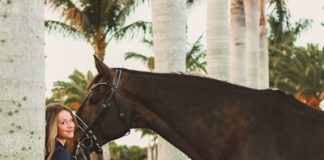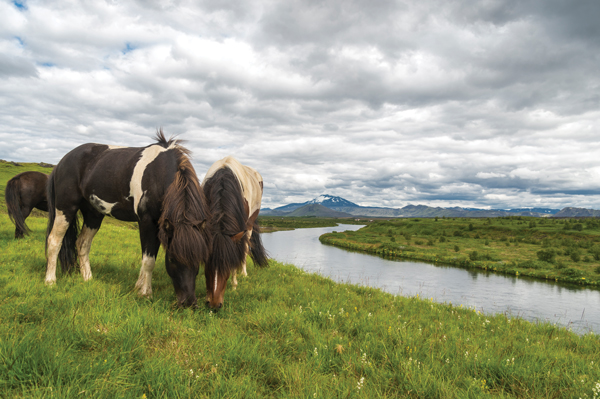
“Now ask your horses to tölt,” instructed Björk Jakobsdóttir, our Icelandic guide. I took a deep breath, lifted my hands and took more contact, scooped my seat under and closed my legs. Klængur, the first of many delightful Icelandic horses I would ride over the week-long adventure on my Iceland horse riding vacation, rewarded me with a few steps of this mystical gait unique to the breed.
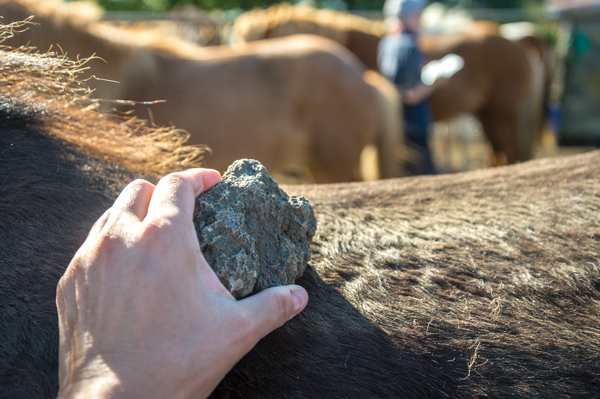
When I got it right, he felt like a speed-boat skimming atop the water: His hind end dropped and came underneath my seat while his front end rose up and filled out the bridle, effortlessly gliding over the ground in comfort.
Decked out in oversized orange weather gear, our group of women headed out of the arena for a two-hour ride around Ölfus, where Eldhestar (literally “volcano horses”), the out-fitter, is located.
Led by Björk and Caroline Owen, better known as “Cline,” representing Wild Women Expeditions, our Canadian tour company, this short hack was both a way for us to get comfortable with a different way of riding and an opportunity for our guides to evaluate our riding experience and comfort level on unfamiliar horses over varied terrain.
I wasn’t feeling much like a wild woman on my horse riding vacation in Iceland as cold raindrops beaded off my helmet brim and soaked into my gloves. But there was something about riding across this land of fire and ice that had called to me. The next six days spent riding around the base of Hekla Volcano in the southwest corner of Iceland with a dozen intrepid women ranging in age from 16 to 60-something would certainly test my mettle, and it would prove to be a transformative experience for each of us.
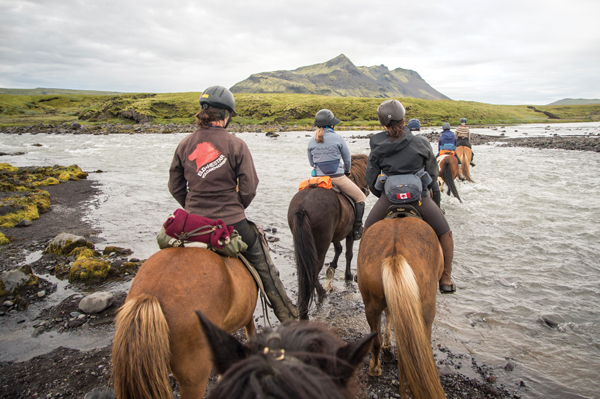
A Different World
Ina, one of our two outriders from Eldhestar, rode around the spacious indoor aboard a flaxen-maned red mare, demonstrating the five gaits of Icelandic horses: walk, trot, canter, tölt and flying pace. She traveled across a plywood “runway” several times at each pace so we could hear the different beats.
Tending to Icelandic horses was quite different from what I’m used to and required some instruction and practice. For example, we learned that lava rocks make perfect grooming tools. They are plentiful, so we didn’t need to carry them in our saddlebags, and they did a fine job at removing dirt and sweat marks.
Tacking up was the next lesson. A dressage-type saddle was placed well behind the shoulder to allow for full range of motion at the tölt, followed by a simple headstall with a snaffle and clip-on reins that double as a lead rope. Finally, a separate drop noseband was slipped on over the bridle.
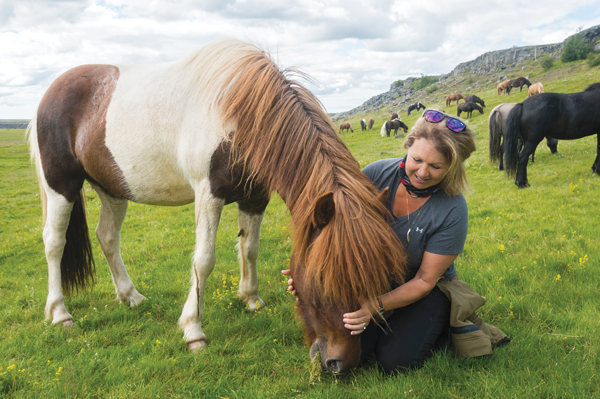
Even mounting required learning new techniques. All mounting was done from the ground, so it was important to ensure the girth (non-elastic) was very tight. Then I stood facing front with my right shoulder against the horse’s left side, slightly behind the saddle, as opposed to standing perpendicular to the horse’s side or facing the rear. This ensures you don’t catch your horse in the side with a toe as you swing your leg over the saddle.
Dismounting required taking both feet out of the stirrups before sliding off. A little tip: If your saddle has rain gear strapped to it, make sure you lift your right leg extra high to clear it or you may find yourself in an ungraceful heap on the ground.
Easing In
That first night away from Eldhestar, our group was scattered in all corners of a one-room community center in Hrólfsstaðahellir that had been converted to our makeshift accommodations. Foam mattresses and sleeping bags littered the floor with our belongings strewn about. Some in our group gathered around Cline, who was playing her guitar; others sat quietly journaling or reading.
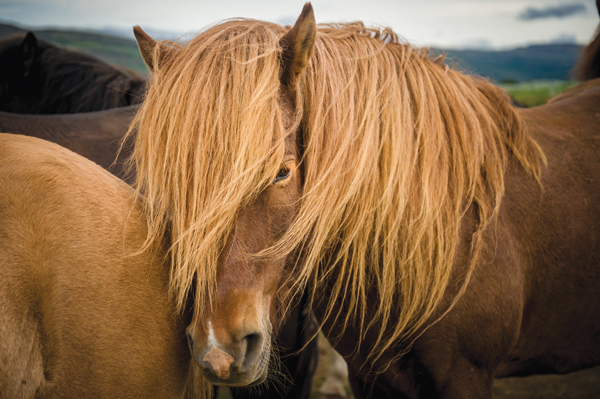
Our first day had been an “easy” 9-mile ride on smooth trails along meadows, a warmup for the days to come. My muscles, not being used to several hours in the saddle and the strength it took to mount from the ground multiple times, had begun to tighten.
Still, I felt accomplished. That morning, I’d ridden what would turn out to be one of my favorite horses of the trip, Kvakur, a leggy gray gelding with the nicest tölt you could ask for. No matter the speed, riding him was as easy as sitting on my couch watching TV. I’d even managed to successfully mount from the ground with only a little sweat.
The herd of 25 or so loose horses caught up with us after we stopped for lunch, and we rode the second half of the day with them. They ran freely with us for the duration of the trip, which allowed each of us to swap to a fresh horse once or twice per ride on my riding vacation in Iceland.
Our group split into two, sandwiching the herd between us. This ratcheted up the challenge: The front group couldn’t go too fast or too slow, and the back group needed to avoid pushing the herd into the front group, while also keeping the horses from spreading out too much.
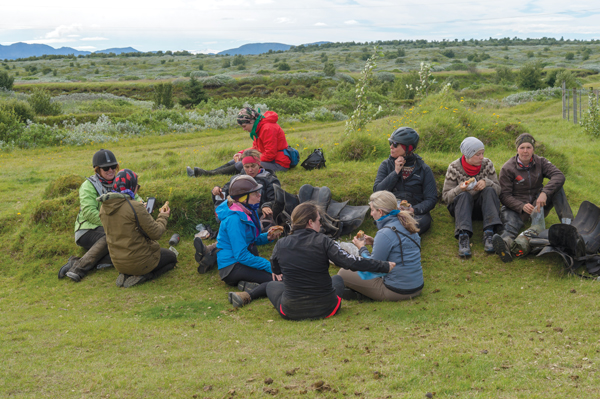
Riding with the herd was a bit rough at first. We’d gotten used to a more leisurely pace and the ability to hop off to fix something if necessary. When my saddle slid up my horse’s neck while going down a steep hill, I quickly hopped off to reset it. Annina, our other outrider, let me know with urgency that this was a bad choice. Once I was back in the saddle, she explained that, even if I was sitting on my horse’s ears, we had to keep up with the herd.
Through the small windows along the top of the community center that evening, we watched the sky slowly fade to yellow and orange. We gathered outside in our pajama staking photos of each other as the sun set behind the hill. It was disorienting to realize it was 11 p.m.; it never really gets fully dark in Iceland in the summer months.
Stretching Ourselves
Each day, we rode anywhere from 12 to 25 miles, sometimes slowly picking our way through fields of lava rocks at a walk, and other times tölting or galloping through emerald meadows past grazing sheep eyeing us from the hillsides.
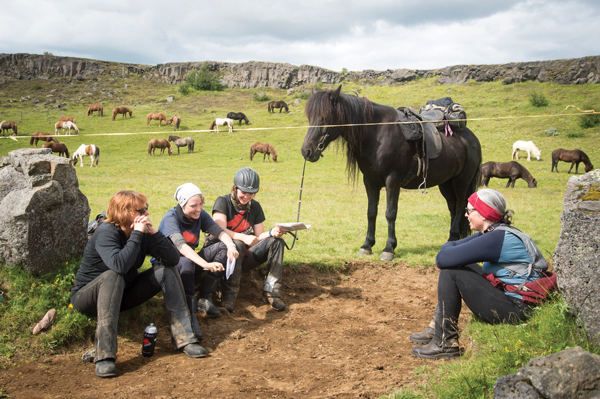
We skirted the edges of canyons with roaring waterfalls, sloshed through pristine rivers with water up over our ankles and explored a cave with a mysterious rusty bell that hung from the top of the entrance. The scent of wild thyme was a constant.
Our ritual before getting into the saddle each morning was yoga. When not leading Wild Women tours in Iceland, Cline owns a yoga studio in Canada. We began to look forward to our morning stretches, almost as much as some people crave their coffee. It helped us work out any residual kinks and warmed up our muscles for the physically challenging day ahead.
It also became a time for our group to bond: breathing, groaning, laughing and feeling grateful for the new experiences, the generosity of the horses, the natural beauty around us and—especially—for each other.
We instinctively kept an eye on each other, particularly those with less experience or who were more timid riding outside the arena. How’s the knee today? Is your back holding up? Are you feeling comfortable back there?
We’d stop for a break and share trail mix to help replenish our energy. At lunch, we’d remove the tack and watch the horses graze or groom each other contentedly while we talked about the horses we’d ridden, our lives, and our families and loved ones at home.
As time passed, discussions became deeper and more personal. We shared our fears, our losses, our failures. We carefully unpacked the baggage of our lives without judgment.
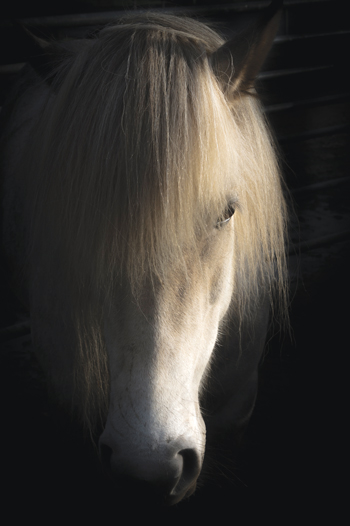
The Longest Day
I pulled my neck warmer up over my nose and mouth to protect from the stinging rain and tiny grains of lava rock pelting my face. Buffeted by a relentless wind, we galloped toward our next overnight stop in the village of Rjúpnavellir.
We’d ridden our longest distance of the trip, and perhaps the longest distance I’d ever covered on horseback—25 miles. My ribs, bruised from my camera bouncing against them for several days, complained loudly.
Fording one last deep stream, we arrived at our cabin for the night. We giggled as we took selfies showing the distinct dirt line where our helmets had covered our foreheads. Three Advil and a wet-wipe bath later to remove grit from every crevice on my body, it was hard not to feel empowered by the accomplishment.
Cline settled in on the couch in front of the fireplace and picked up the sweater she was knitting. I mindlessly untangled and balled her yarn while we all sat and talked some more—getting and giving new perspectives, and feeling truly acknowledged by our new sisters.
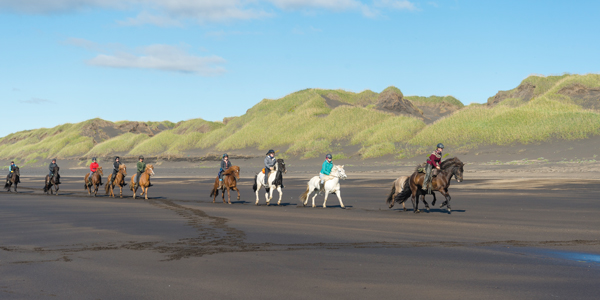
The Last Ride
In single file, our group galloped down the black sand beach, playing in the North Atlantic surf on a sunny, warm day. I got to ride my favorite horse Kvakur again, and it was impossible to suppress my grin.
But at the same time, the familiar mix of euphoria and melancholy that often creeps in at the end of a meaningful adventure had arrived. I’d covered 100 miles in the saddle, pushed through mental and physical discomfort, embraced the morning yoga stretching sessions and bonded with this special group of women. Yet I was acutely aware that our time together was quickly coming to an end.
We meandered toward Eldhestar, taking in every sense and savoring every experience. The horses splashed through the shallow water along the Ölfusá River delta, occasionally drop-ping their heads to sip the icy water.
At our final lunch stop of the trip, I untacked and turned out my horse in our makeshift paddock. I lay on the ground using my saddle as a bolster, watching the herd interact while marveling at the centuries of selective breeding that allows these generous horses to carry us smoothly and safely over such harsh terrain.
The group was unusually quiet as we each reflected on our personal journeys that week. A sense of gratitude for the horses, the land, the experience, and my new friends enveloped me.
While we had all been in the same place, we each took away something different from our horse riding vacation in Iceland. For me, it was learning that “roughing it” wasn’t so bad, and that I’m mentally and physically stronger than I often give myself credit for.
One takeaway we all shared: Our individual comfort zones had greatly expanded over the week. Maybe I am a wild woman after all.
8 Packing Essentials1. Icelandic horses are a closed herd, meaning that no horses are allowed to come onto the island from other countries. Because of this, there are no infectious equine diseases. Therefore, boots and helmets must be new or fully disinfected, and gloves must be new. 2. While Eldhestar had a large variety of horse riding helmets available to borrow for your vacation in Iceland, I brought my own—one I purchased for the trip—because I wasn’t confident about how the helmets had been maintained. 3. Wear breeches or tights; jeans may rub. I brought two pair of lightweight silicone full-seat tights, which offered the perfect amount of stretch and stickiness in the saddle. Plus they were quick-drying and comfortable for wearing around the cabins at night. 4. Waterproof tall country boots are comfortable for both riding and walking on Iceland’s rough terrain. You may be walking in streams or riding in high water, and wet socks aren’t fun. 5. The weather can change quickly. My go-tos included a light base layer (top and bottom), long-sleeve pullover, light fleece, packable down vest and a waterproof windbreaker. 6. Bring a bug net. The lightweight mesh fits over your helmet and keeps swarms of insect out of your face. You won’t need it all the time, but when you do, you’ll be glad you have it. 7. A neckwarmer or bandana is critical for protecting yourself from pelting lava rocks and inhaling dust. Plus, it doubles as a scarf, hair accessory and sleeping mask. 8. A waist/trail pack is useful for stashing your phone/camera, tissues, sunglasses, bug net, lip balm, sunscreen and other necessities. |
This article about a horse riding vacation in Iceland appeared in the November 2019 issue of Horse Illustrated magazine. Click here to subscribe!




